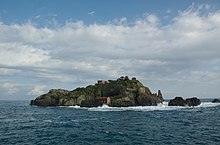Lachea
Lachea (also Isola di Aci ) is the largest island of the Cyclops Islands , located a good 100 meters from the port entrance of the Sicilian town of Aci Trezza . It covers a surface of around two hectares and rises up to 35 m slm
The origin of the name is believed to be in a Byzantine Greek word that means 'flat'. The name Aci refers to the mythical figure of Akis ; the underlying Greek name Akis ( Greek Ἄκις ) is originally a river name, Aci is a toponym that is common in eastern Sicily.
The island is, like the rest of the archipelago, of sub-volcanic origin, it is part of an approximately one kilometer long laccolite , which was formed by intrusion of magma between the pre-existing submarine rocks, was partially eroded by the waves and thus formed the Cyclops Islands. The basalt core of the island is covered by a whitish layer of clay which, through contact with the lava, has produced some characteristic minerals such as analcime and which has hardened to a thickness of 10-15 m.
Several archaeological discoveries were made on the island: in 1869 a prehistoric diorite ax was found ; In 1919 two cave graves were identified that had been carved into the rock by human hands. From the late Roman period, objects from the late Roman period were found inside one of two large, approximately one meter deep, circular holes, including pots, amphorae , weights from a loom, nails and fragments of a comb made of bone, and a small lamp.
At the highest point of the island there is a museum, a cistern and the Grotta del Monaco ("monk's grotto"). The natural history museum houses a rich selection of flora and fauna from the island and exhibits archaeological and geological finds from the island. Lachea is covered in lush vegetation, including species endemic to Sicily and southern Italy such as solstices and the boarwort species Carlina corymbosa . As far as the fauna is concerned, two types of smooth- bellied spiders are particularly noteworthy, the Zelotes messinai , which is endemic to Sicily, and the Urozelotes mysticus, which has so far only been found on the island . The isolated location has also given birth to the endemic subspecies Podarcis sicula ciclopica of the rock lizard .
The bird world is mainly characterized by migratory birds that use the island as a resting place. Particularly common to find wagtail , Spanish Sparrow , Magpie , Linnet , Whitethroat , Woodlark , Sardinian Warbler , Cormorant , Mittelmeermöwe , marsh harrier and peregrine falcon .
Lachea is the seat of a biological research station of the University of Catania and is protected along with the entire archipelago. At the end of the 20th century, a brown algae discovered here was named Taonia lacheana .
literature
- G. Sciacca: Tra lava e mare: alla scoperta di una delle più belle aree marine della Sicilia , in: Sikania, No. 257, 10 May to 10 June 2008, 24th year.
Individual evidence
- ↑ [ Archived copy ( memento of the original from September 20, 2008 in the Internet Archive ) Info: The archive link was inserted automatically and has not yet been checked. Please check the original and archive link according to the instructions and then remove this notice. American Institute of Southern Italian Studies (AISIS): Encyclopedia of Southern Italy [Volume 1] ]
- ↑ Etymology of local toponyms ( Memento of the original from February 10, 2005 in the Internet Archive ) Info: The archive link was inserted automatically and has not yet been checked. Please check the original and archive link according to the instructions and then remove this notice. on acitrezza.com (Italian)
- ↑ Description of the species on algaebase.org (Eng.)
Coordinates: 37 ° 33 ′ 41 ″ N , 15 ° 9 ′ 59 ″ E
